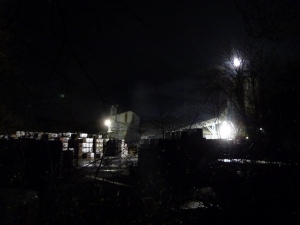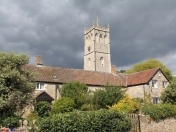
Please see below a message BOB received regarding the very bright Quarry lights affecting our wonderful dark skies:
"I have contacted North Somerset Council about this issue with the quarry lights and have today received a call from a local environmental officer. It seems there's little we can do ourselves as the legal position seems to be based around intrusive light into the home. As we in our location ... don't have these terrible lights beaming directly into our house then our hands are tied somewhat. Do you know if anyone else in the village nearer to the quarry has raised the issue? If so, if we can get further calls into NSC to complain then I think there's a decent chance of getting a result based on what I've been told today."
These lights can also affect our wildlife like Bats too, so is your environment/home/garden adversely affected at all by the bright quarry lights and if so, would you be willing to complain to NSC directly or alternatively, for BOB to pass on your name and details to be contacted with further details?
Residents in the immediately vicinity have already started to respond to NSC but would like your support, so please reply and I will pass on the message as appropriate, it would also be very helpful if you could also inform your friends and neighbours too.
-------------- Further related information below --------------
BOB 08/12/2017 email to NSC Development and Environment Department:
We have been passed your contact details with regard to the above issue.
As you maybe aware many Bleadon residents have noticed that the Bridge Road, Bleadon (Marshalls) Quarry 'yard lights' are now very much noticeably brighter, possibly because they have been 'upgraded' to LED lamps. Apart from the increased intrusive 'light pollution' into neighbouring properties (I understand some residents have already made complaints), and the loss of our valued 'dark skies', many other Bleadon nature lovers are also concerned about the effect on wildlife, particularly nocturnal mammals like Bats.
We believe that the Quarry is within a known feeding habitat range of legally protected species of Bats. See http://jncc.defra.gov.uk/protectedsites/sacselection/sac.asp?EUCode=UK0030052
Also see attached information from Bat Conservation Trust and according to North Somerset Council Local Plan (Core Strategy) Development Management Policy DM8 "Development proposals should ensure that, where appropriate, provision is made for: any lighting scheme to avoid adverse impacts on light averse wildlife"
Please can you confirm that the original quarry lighting scheme was approved under relevant past and present NSC Local Plan policies and also if the Quarry lighting 'system' has subsequently been upgraded or changed, and whether this should also need NSC approval?
If this is not a responsibility or concern of Environmental Protection, please can you forward/advise to whom this should be referred E.g: Planning Policy Enforcement or perhaps another relevant NSC or public service department?
For reference: North Somerset Council Local Plan (Core Strategy) Development Management Policy DM8 is here https://www.n-somerset.gov.uk/wp-content/uploads/2015/11/Sites-and-Policies-Plan-Part-1-Development-Management-Policies-July-2016.pdf
Below is information received from Bat Conservation Trust.
Thank you for contacting the Bat Conservation Trust about bats and lighting. We are a small charity and regrettably cannot get involved in individual cases. We therefore rely on concerned residents like yourself to help us protect bats by bringing matters such as this to the attention of relevant authorities.
Bats are amazing animals that are important to ecosystems in the UK and worldwide. As natural roosting sites have become scarce so the number of artificial roost sites has increased in the form of houses, bridges, barns etc. We have 18 species of bat in the UK, all of which are protected under UK and European law such that it is illegal to damage, destroy or disturb any bats or roosts. A roost is defined as any place that a wild bat uses for shelter or protection, and the roost is protected whether bats are present in it or not. The ‘Supporting Legislation’ section in ‘The planning system’ leaflet attached provides a more in-depth overview of bats and the legal system.
Bats and lighting
Bats are nocturnal animals that have adapted to low light conditions. Therefore the artificial lighting of bat roosts, access points and foraging pathways can be disturbing to bats and should always be avoided as much as possible. Artificial light falling on or close to a bat roost can delay or prevent the bats’ emergence, resulting in reduced foraging time and missing the peak time of insect abundance (just after dusk). As all bats in the UK feed on insects this missed opportunity can have a serious impact on their survival.
Artificial light falling onto roost access points can in some cases lead to bats abandoning the roost, which is likely to be considered a breach of legislation as both bats and their roosts are protected by law.
Artificial lighting has also been found to affect the feeding behaviour of bats away from the roost. Slower flying species (lesser horseshoe, greater horseshoe and the 6 Myotis species) avoid illuminated areas and therefore lose foraging grounds if they are lit. This results in slower flying species having to use poorer quality foraging sites and losing out on prey, which are attracted to the surrounding lit areas. Unfortunately these light-avoiding species include all of the UK’s rarest bat species. However, even our faster flying species recorded more widely (noctule, Leisler’s, serotine and pipistrelle bats) can be impacted by artificial lighting. Some may feed under streetlamps, as insects are attracted to the short wave length light they emit (UV), but suitable commuting and foraging routes have been shown to be avoided if there is artificial light spill onto these areas.
It is very important to take bats into account when planning to light an area they are known or suspected to use. There are a number of factors that will need to be considered under expert guidance, such as:
- Which species are present?
- How are they using the habitat – roosting, commuting, foraging, etc.?
- What are the existing light levels?
- Have the principles outlined in the attached lighting guidance been applied? (e.g. Minimising spread of light, considering height of lighting columns, using appropriate lighting sources, minimising amount of space and time lit, using fencing to protect dark areas etc.)
In the first instance we would recommend that the owner of the property is informed of the presence of bats and the potential for lighting to affect them. As bats and their roosts are protected by law if bats are known or suspected to roost in an area that needs to be illuminated a survey will need to be completed prior to work being carried out. The owner is welcome to contact our helpline on 0345 1300 228 for more information and help ensuring the bats are not affected.
If the council is involved (e.g. if planning permission is required) we would suggest that you contact the local council planning authorities and alert them to the presence of bats and the need for a survey before works proceed. The most effective way to contact your local authority is in writing, but we advise that you follow this up with a phone call to ensure your enquiry is on record. Where possible we would also encourage you to send the letter to the applicant making them aware of possible bat presence.
To ensure your letter is taken seriously we recommend you:
· Don’t include hearsay or information you are unsure about.
· Don’t include unsubstantiated criticism of the property owner, e.g. personal circumstances or character.
· Don’t exaggerate your claims.
· Don’t include information unrelated to the issue of the lighting.
· Don’t make reference to the effect of the lighting on property values.
If your enquiry relates to pre-existing lighting you may be directed to Environmental Health (who deal with disturbance to people). In that case, you will need to make it clear that your enquiry relates to the impact on wildlife and needs to be directed to the appropriate person.
If you witness an offence being committed (e.g. bats being disturbed or a roost entrance being illuminated) please inform the Police Wildlife Crime Officer in your local area by calling 101 or calling the local Police Force directly, mentioning ‘Operation Bat’ and request an incident number. (If the Wildlife Crime Officer is not available it should not affect the reporting of the incident, please do so anyway). Please also report this incident along with the incident number obtained from the Police to the Bat Conservation Trust so we can follow this up. If you are aware of a licence breach in Scotland, Wales or Northern Ireland this should also be reported to the police in the same way. If the licence breach is in England however, then the matter should be reported to Natural England’s Wildlife Enforcement Specialist on 0300 060 1099.
The documents attached (Artificial Lighting Wildlife, Helping to Protect Bats and Living with Bats) provide more information on bats and lighting in the UK. I also recommend visiting the lighting section of our website: http://www.bats.org.uk/pages/bats_and_lighting.html
You can also find information from our 2014 Artificial Light and Wildlife Symposium, including video clips of talks on our website: http://www.bats.org.uk/pages/artificial_light_and_wildlife_symposium_determining_solutions_for_practitioners.html
I hope this information is helpful for you. If you have any further questions please contact the National Bat Helpline on 0345 1300 228.
Kind regards,
Bat Advice Officer
Out of Hours project coordinator
Lot coordinator for East Midlands and Yorkshire
National Bat Helpline, Bat Conservation Trust, Quadrant House, 250 Kennington Lane, London SE11 5RD
Helpline: 0345 1300 228 - Please note that the helpline number has changed
Office (9am – 5:30pm): 020 7735 6663
Fax: 020 7820 7198
-----------------------------
Above response to email below from BOB 15/12/2017



Make A Comment
Comments (2)
Sent: 08 December 2017 13:01
To: NSC
Subject: Bleadon Quarry Lighting
Dear NSC Environmental Protection,
We have been passed your contact details with regard to the above issue.
As you maybe aware many Bleadon residents have noticed that the Bridge Road, Bleadon (Marshalls) Quarry 'yard lights' are now very much noticeably brighter, possibly because they have been 'upgraded' to LED lamps. Apart from the increased intrusive 'light pollution' into neighbouring properties (I understand some residents have already made complaints), and the loss of our valued 'dark skies', many other Bleadon nature lovers are also concerned about the effect on wildlife, particularly nocturnal mammals like Bats.
We believe that the Quarry is within a known feeding habitat range of legally protected species of Bats. See http://jncc.defra.gov.uk/protectedsites/sacselection/sac.asp?EUCode=UK0030052
Also see attached information from Bat Conservation Trust http://www.bats.org.uk/pages/bats_and_lighting.html and according to North Somerset Council Local Plan (Core Strategy) Development Management Policy DM8 "Development proposals should ensure that, where appropriate, provision is made for: any lighting scheme to avoid adverse impacts on light averse wildlife"
Please can you confirm that the original quarry lighting scheme was approved under relevant past and present NSC Local Plan policies and also if the Quarry lighting 'system' has subsequently been upgraded or changed, and whether this should also need NSC approval?
If this is not a responsibility or concern of Environmental Protection, please can you forward/advise to whom this should be referred E.g: Planning Policy Enforcement or perhaps another relevant NSC or public service department?
Kind regards,